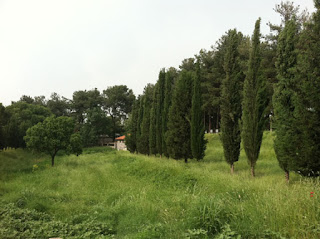I toured ruins of Ephesus during my trip to Turkey and found wonderfully preserved and picturesque ruins. The town started off as one of the twelve cities in the Ionian League during the classical Greek era and was later the major Roman commercial port town of Asia Minor. The city boasted a population of 250,000 people which made it one of the largest in the Mediterranean world.
Founded by Androclus the city was famed as the site of the Temple of Artemis, one of the 7 Wonders of the Ancient World. Emperor Constantine I undertook a major renovation plan including the creation of a large bath complex but in 401 AD Theodosius I issued the edict of Thessolonica and the the great temple was destroyed by an angry mob led by St. John Chrysostom.....yet another reason proving that fanatics are not very bright.
The town took another hit in 614 AD when it was partially destroyed by an earthquake and the city's importance continued to wane as the port slowly silted up by the Caster River.
Today the sight is about 3 kilometers south of Selcuk, Izmir, Turkey.
A beautiful row of trees leads you into town.
The Hellenistic Fountain House from 200 BC
The Theater of Ephesus
The theater held up to 24,000 people. Construction began in the Hellenistic period but continued under Claudius [41-54 AD] and Nero [54-68 AD] added a new stage. Some of the remaining decoration can be dated to Trajan [98-117AD]
The Library of Celsus c 125 AD
The facade has been reconstructed with all original pieces.
It was originally built by Gaius Julius Aquilla in memory of his father Tiberius Celsus Polemaeanus, a Greek who served as governor of Roman Asia [105-107]. The library once held over 12,000 scrolls and was paid for entirely with private funds, it also served as final resting place for Celsus who is buried in crypt sarcophagus. The exaggerated facade was designed to enhance perceived size and the eastern inclination allowed the reading rooms to have morning light.
The portico
Looking up
One of four beautiful statues
The Gate of Augustus
Just to the right of the Library of Celsus is the imposing Gate dedicated to Augustus, his wife Livia and his son-in law. It was also called the Gate of Mazaeus and Mithridites and led to the agora where food and goods were sold...it seems to have also been a favorite place for ne're do wells to relieve themselves as there's an inscription that curses 'those who piss here'.
The Temple of Hadrian
This 2nd c temple has been recreated from surviving fragments. the reliefs are casts as the originals are in the Ephesus Archeological Museum.
Detail of the frieze
Wonderful mosaic floors 5th c along Curetes Street
The public toilets, not far from the Gate of Augustus
The Brothel of Ephesus
Gate of Herakles
The Polio Fountain built by Laecaneus Bassus
The Street of Curetes, the Imperial street lined with temples fountains and the houses of the rich. [ See our
terrace house blog]
The Odeon
The arched entry to go inside the theater
Was presented to the city in 150 AD by Vedius Antonius and his wife. It served as a small salon for concerts and doubled as the City Council chambers.
Just beyond was the Temple o Augusts and Livia.
One of the side entrances
Ephesus has a huge gladiator's grave yard. This stone shows grieves helmet and sword.
The Basilica of the Church of the House of Mary.
Looking from the gymnasium to the Agora and the Theater beyond.
Go in the early afternoon and avoid the crowds.
































No comments:
Post a Comment